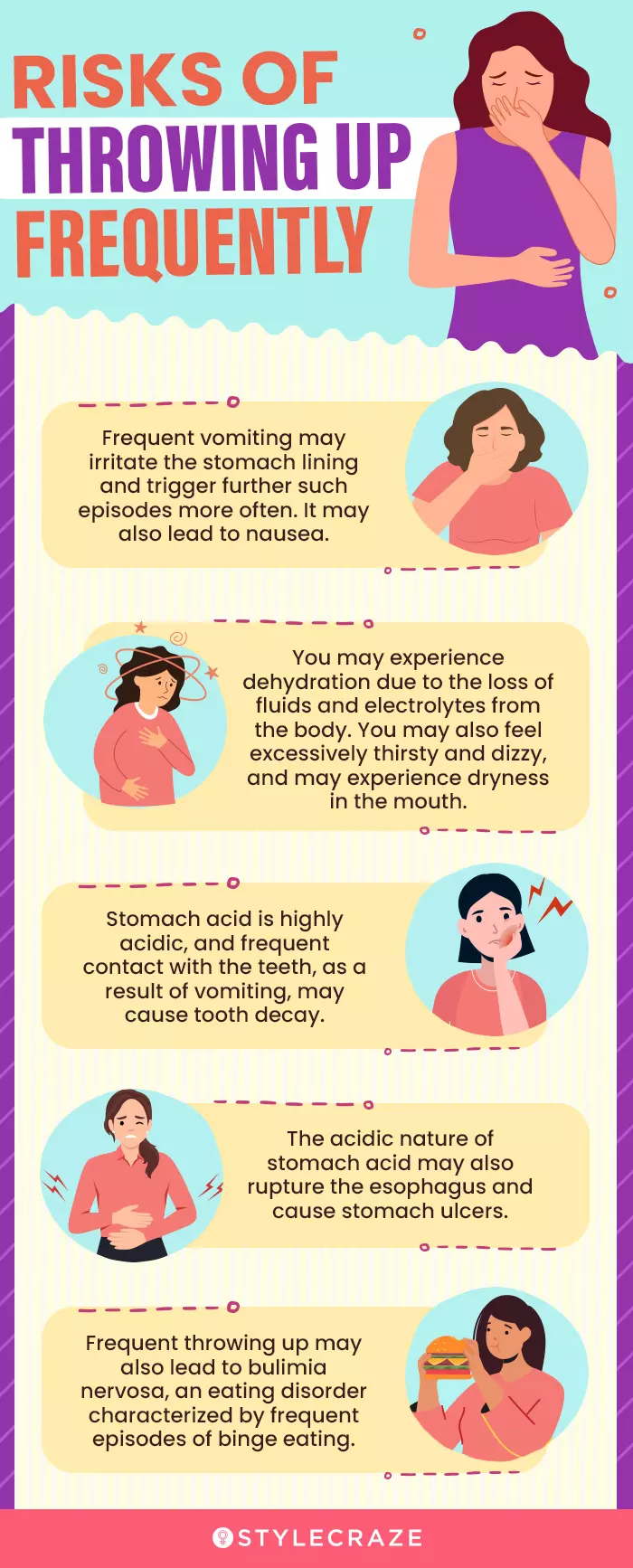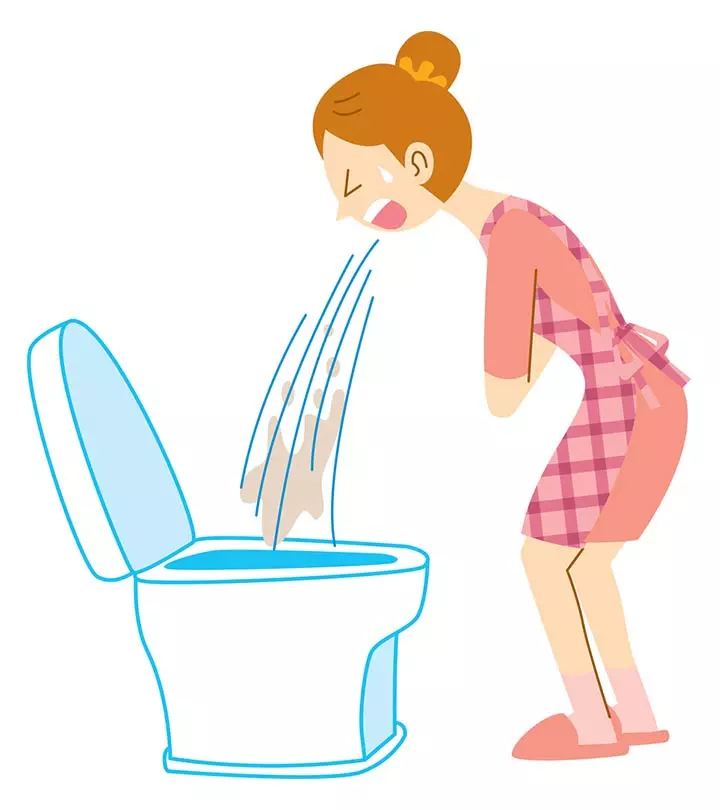How To Make Yourself Throw Up Easily When You Are Sick
Learn some easy and safe ways to induce vomiting for relief when all else fails.

Image: iStock
When you swallow something toxic or harmful and start feeling nauseous, it’s your body’s way of telling you something is wrong and needs to be eliminated.
One of the ways to do that is to make yourself throw up.
While vomiting can provide you relief, it should only be done when all other methods fail. Christine Kingsley, Advanced Practice Registered Nurse, says, “Unless otherwise suggested by a healthcare provider, inducing vomiting on your own is a no-no.” She adds, “In most instances where people feel justified to force themselves to puke, such as poisoning, this practice is still not medically recommended. This is because our bodies already have a fail-safe method put in place in case of ingestion of any harmful substance or matter.” She adds, “Puking on your own only interferes with that natural process and further endangers your life. In fact, hurling alone rarely expels 100% of toxins, so visiting the emergency room is always the only solution any time you feel like puking what you ingested is necessary.”
Ideally, consult a doctor before you resort to this, as an induced retch may cause certain damages to your body. In this article, we take a look at 10 easy ways to induce vomiting and the side effects of doing it.
In This Article
When To Induce Vomiting
Do not induce vomiting unless medically advised because it can take a toll on your overall health. That said, there may be a few instances where you would have to make yourself throw up:
- If you ingest anything poisonous or harmful, like pills or chemicals
- If you experience severe indigestion or gastric pain
However, forcing yourself to regurgitate every other day can cause severe issues. Some individuals tend to make a habit of inducing vomiting. This repetitive behavior can strain the esophagus and the upper respiratory system. It may potentially rupture the food pipe and throat tissues.
Do not resort to vomiting to treat anything that may make you feel blue. However, if the situation calls for it and your only alternative is to vomit, and you feel like ‘I want to vomit but I can’t’, you can try any of the following methods to help you throw up.
Caution: Consult your physician beforehand and look for alternative treatment options too. Do not use these methods to lose weight.
10 Easy Ways To Make Yourself Throw Up
1. Use Your Finger
Pushing your finger down your throat, over your tongue, will help induce vomiting.
Why This Works
When your finger comes in contact with the base of your tongue, your body reacts and causes a gag reflex (1). This, in turn, makes you nauseous and prompts you to upchuck.
 Quick Tip
Quick TipEnsure that you clean your fingers thoroughly to prevent the transmission of infection.
2. Drink Warm Salt Water
Add a teaspoon or two of salt to a glass of warm water. Consume this saline solution in a single gulp. It may take 25 to 30 minutes to induce vomit, but you can use your finger to speed up the process.
Why This Works
Salt contains sodium. Excess sodium can cause a shift in the natural electrolyte balance of your body and force you to expel the saltwater.
3. Gargle
Add a teaspoon of salt to a glass of warm water. Stir to dissolve it and take a sip of saltwater and hold it in your mouth. Tilt your head slightly and keep gargling for at least 10 minutes.
Why This Works
Gargling with warm water triggers a gag reflex, which induces vomiting. However, the gargling should be intense. You can also add salt to the warm water gargle to further accelerate the process.
4. Use A Toothbrush
You also can use your toothbrush to induce vomit. This method will be especially helpful if you aren’t comfortable with the idea of sticking your finger down your throat. You may rub your toothbrush against the back of your tongue and watch yourself throw up almost immediately.
Why This Works
The toothbrush causes a gag reflex that causes you to spew up.
5. Think About Vomiting
Think about vomiting and all things that make you sick to compel your body to throw up.
Why This Works
When you focus your mind on the sights, smells, and sounds that make you sick, you feel nauseated and tend to vomit.
6. Gargle With Egg Whites
Think of gargling with egg whites, and the thought itself may make a few purge. If that doesn’t work, you may separate the whites from the egg and gargle with them.
Why This Works
The unpleasant smell and taste of raw egg whites can cause you to heave up all stomach contents almost instantly.
7. Think Of An Unpleasant Smell Or Sight
Think of any unpleasant smell (like that of a medicine you didn’t like) or any sight that put you off.
Why This Works
Unpleasant views and smells can stimulate you to throw up. The neurons in your brain can cause you to become sick as a reflex action to such stimuli.
8. Take Baking Soda
Mix a teaspoon of baking soda in a glass of water and gulp it down.
Why This Works
Baking soda (sodium bicarbonate) has been used to induce vomiting. One of the many side effects of consuming too much sodium bicarbonate is nausea and vomiting (as the body tries to correct the salt balance by drawing water into the digestive system). However, caution should be exercised while following this method as it may lead to severe complications (2).
9. Mustard Solution
Mix a teaspoon or two of mustard in a glass of water and drink the solution in one go.
Why This Works
Mustard possesses natural emetic properties. Consuming it can make you nauseous and induce vomiting (3).
Caution
Do not make this a habit. Mustard contains high amounts of sodium, and excess sodium is not good for your health. Consult your doctor before you opt for this remedy.
10. Bloodroot Herb
Mix some bloodroot powder in a glass of water and consume it.
Why This Works
Bloodroot, also known as bloodwort, is a plant used traditionally to cure various health issues. Although this herb is of medicinal importance, it is also known to induce nausea and vomiting (4).
Caution
Bloodroot is quite toxic in high doses. Talk to your doctor before trying it.
Note: There may be instances when you feel like throwing up but don’t want to. Avoid looking for ways on how to not throw up. Throwing up can be your body’s way of expelling bad food from your system. Additionally, there are also a set of unsafe methods on how to throw up. These include using medications for inducing vomiting and using unsafe things to trigger gag reflex.
Things To Do After You Throw Up
- Take a hot shower.
- Blow your nose to remove any residue of vomit from your sinuses.
- Gargle with a mouth wash to get rid of the pungent smell.
- Sip on water to keep yourself hydrated.
- Have a light meal.
- Drink cranberry juice to get rid of the bad breath or the bittersweet taste in your mouth, ginger ale to calm your stomach, and Gatorade or ORS to rehydrate yourself.
 Quick Tip
Quick TipAs you are already aware, self-induced vomiting, if done repeatedly, can have negative effects on your body. We have discussed them below.
Side Effects Of Throwing Up
Throwing up always comes with side effects and risks. Christine Kingsley, Advanced Practice Registered Nurse, says, “Self-induced vomiting is never a good idea, given that our bodies are designed to adapt to whatever we demand from them. Forcing vomiting will result in being more prone to throwing up.” She also adds, “Chronic puking, self-induced or not, also triggers imbalances in bodily fluids. It can put you in a constant state of dehydration, impairing bodily functions and internal processes, which ultimately creates severe health issues over time.”
Repeatedly inducing vomit can cause the following side effects:
- Your body may become prone to vomiting and you may experience a continued feeling of nausea.
- You may experience dehydration and loss of electrolytes, as your body majorly loses water content and electrolytes when you vomit.
- Your stomach acid may erode your teeth and mouth. At times, you may experience the sour taste and oral lesions that cause redness and irritation.
- You may experience acid refluxes or even ulcers that may need medical attention. You may also experience gastric pain, headaches, and body aches.
- You may develop an eating disorder called bulimia, where you may secretly tend to consume large amounts of food and then try to get rid of those extra calories through unhealthy means. You also may develop food aversions and sensitivity towards smells and taste.
Vomiting can have multiple causes. Learn more about them in the next section.
What Can Cause Vomiting
- Viral Infections: Gastroenteritis, often caused by viruses such as norovirus, can cause vomiting and diarrhea (5).
- Food Poisoning: Consuming contaminated or spoiled food can upset your stomach and cause vomiting (6).
- Pregnancy: Many women experience symptoms of morning sickness during early pregnancy, including vomiting, dizziness, and mood swings (7).
- Migraines: These severe headaches can also cause nausea and vomiting (8).
- Chemotherapy: Some medications or treatments, especially chemotherapy, may induce vomiting as a side effect (9).
- Emotional Stress: Intense emotions, anxiety, or stress can also lead to nausea and vomiting (10).
Infographic: Risks Of Throwing Up Frequently
In some cases, throwing up can be an option, especially when one swallows something poisonous or feels extremely nauseated. But this should be done only if a medical professional recommends it. However, a few people may forcefully throw up frequently to cope with mild nausea or overeating, which may have several adverse effects on your overall health. Check out the infographic below for more details.

Illustration: StyleCraze Design Team
Making yourself throw up when you swallow something toxic or feel nauseous can provide relief. Using your finger to trigger the gag reflex can induce vomiting. Drinking warm saltwater and thinking about vomiting can also help induce vomiting. Gargling with egg whites, exposure to unpleasant sights and smells, and taking baking soda, mustard solution, and bloodroot powder can help induce vomiting too. But repeatedly inducing vomiting may cause a continuous feeling of nausea, dehydration, teeth eroding, and acid reflux. Hence, try opting for these methods only if you feel your condition can get better after throwing up.
Frequently Asked Questions
What is a comfortable position to vomit in?
One of the most comfortable positions to barf in is kneeling on your fours. Remember to take deep breaths before you vomit.
What to do if you or someone swallowed something harmful?
If you or someone in your vicinity swallowed or ingested something harmful, call for medical assistance without any delay. Meanwhile, try to spit out the substance. Do not consume any liquids or water.
How to treat poisoning?
Poisoning can be fatal at times. Call for medical assistance and meanwhile, if the person is still conscious, make them sit still and ask them to spit out any remains. If they are throwing up or spilling on their clothes and surroundings, wipe the mess carefully without contaminating yourself.
If the person is unconscious, try to wake them up and encourage them to spit the remains if any. Try to lie the person in the recovery position with a cushion behind their back and their upper leg pulled slightly forward, so that they don’t fall on their face or roll backward.
What medicine can make you throw up?
Drugs that trigger throwing up are emetics. These are common “over-the-counter” drugs that can trigger vomiting by initiating contractions in your stomach. But they should not be used without being medically advised.
Why does it hurt when you vomit?
Vomiting causes abdominal pain as stomach acids travel backward through the digestive tract, irritating tissues from the stomach to the throat.
Why don’t I feel like eating after puking?
This is because of irritation due to stomach acid that is often followed by dehydration. Take rest for 30 minutes and try sipping some lukewarm water or a fruit slice to combat the irritation.
How do I get rid of the bittersweet taste after vomiting?
Try to chew sugar-free gum or suck hard candies with mild flavors. If the rancid taste remains even after 35 to 45 minutes, try a rinse with a solution made using 5 grams of baking soda, half tablespoon salt, and 4 cups of warm water. Drink 6 to 8 glasses of water to combat dehydration after throwing up.
Does making yourself throw up make you lose weight?
No, vomiting does not make you lose weight. In fact, vomiting immediately after eating will not even reduce 50% of the calories that you just consumed. It also is a very unhealthy way to reduce weight.
Why does vomiting make you feel better?
After vomiting, the feeling of nausea immediately subsides. There also is an increased production of saliva and a release of chemicals that make you feel better and give you a sense of relief.
Key Takeaways
- Hurling alone is only advisable in very few cases; for example, if you ingest any poisonous chemicals or experience severe gastric pain.
- Drinking warm salt water, gargling, or pushing your finger down your throat are ways to make yourself throw up.
- However, chronic puking may lead to several side effects, such as impaired bodily functions and internal processes, dehydration, and may even develop into an eating disorder, such as bulimia.
While vomiting is plainly undersireable, sometimes it can actually be a way to feel better. Watch this video to learn how to make yourself throw up with these 8 simple steps.
References
Articles on StyleCraze are backed by verified information from peer-reviewed and academic research papers, reputed organizations, research institutions, and medical associations to ensure accuracy and relevance. Read our editorial policy to learn more.
- Physiology Gag Reflex
https://pubmed.ncbi.nlm.nih.gov/32119389/ - Hemorrhagic Encephalopathy From Acute Baking Soda Ingestion
https://www.ncbi.nlm.nih.gov/pmc/articles/PMC5017849/ - Brassicaceae Mustards: Traditional and Agronomic Uses in Australia and New Zealand
https://www.ncbi.nlm.nih.gov/pmc/articles/PMC6017612/ - Sanguinaria canadensis Traditional Medicine Phytochemical Composition Biological Activities and Current Uses
https://www.ncbi.nlm.nih.gov/pmc/articles/PMC5037693/ - Norovirus
https://www.ncbi.nlm.nih.gov/books/NBK513265/ - Food poisoning outbreak investigation in Dewachefa woreda, Oromia Zone, Amhara Region, Ethiopia, 2018
https://www.ncbi.nlm.nih.gov/pmc/articles/PMC6604335/ - Emerging progress in nausea and vomiting of pregnancy and hyperemesis gravidarum: challenges and opportunities
https://www.ncbi.nlm.nih.gov/pmc/articles/PMC8785858/ - Clinical predictors for migraine in patients presenting with nausea and/or vomiting
https://www.ncbi.nlm.nih.gov/pmc/articles/PMC3816187/ - Chemotherapy-induced nausea and vomiting: optimizing prevention and management
https://www.ncbi.nlm.nih.gov/pmc/articles/PMC4046471/ - Psychogenic vomiting: A case series
https://www.ncbi.nlm.nih.gov/pmc/articles/PMC8611529/
Read full bio of Dr. Vignesh Devraj
- Christine Kingsley is an Advanced Practice Registered Nurse (APRN) and the Health and Wellness Director at the Lung Institute. She specializes in treating patients with various lung diseases and helps them achieve and maintain healthy lifestyles.
 Christine Kingsley is an Advanced Practice Registered Nurse (APRN) and the Health and Wellness Director at the Lung Institute. She specializes in treating patients with various lung diseases and helps them achieve and maintain healthy lifestyles.
Christine Kingsley is an Advanced Practice Registered Nurse (APRN) and the Health and Wellness Director at the Lung Institute. She specializes in treating patients with various lung diseases and helps them achieve and maintain healthy lifestyles.
Read full bio of Arshiya Syeda
Read full bio of Dipti Sharma






























